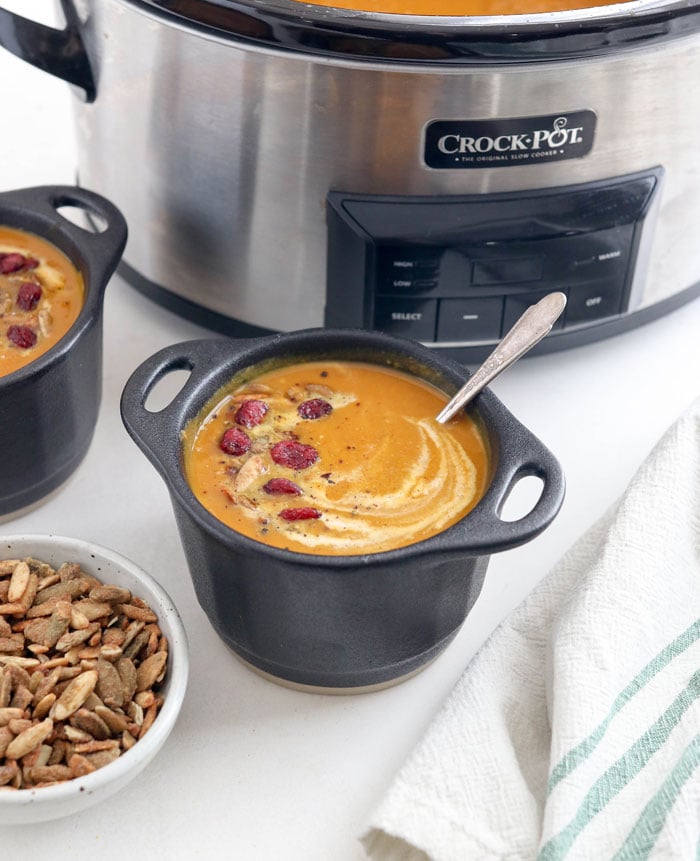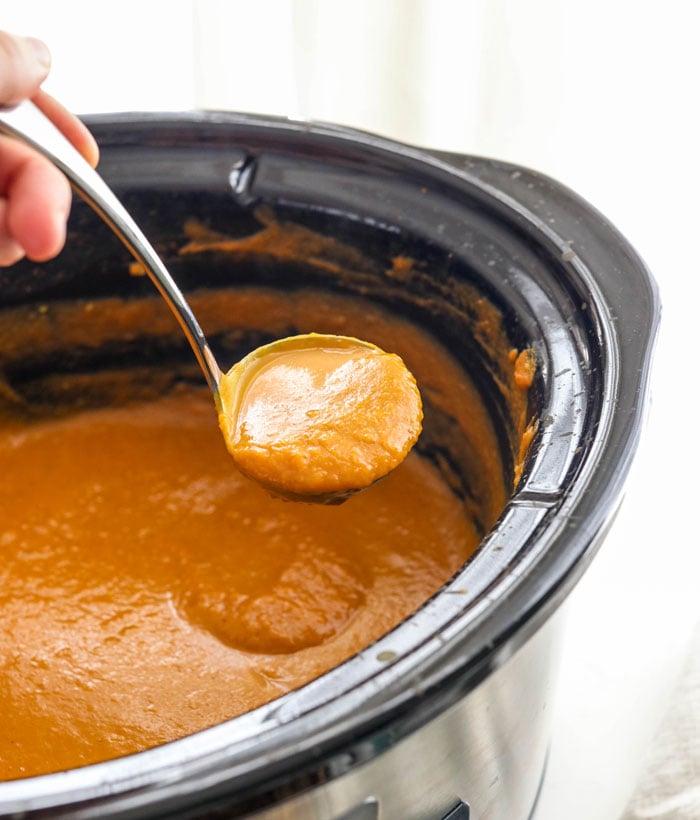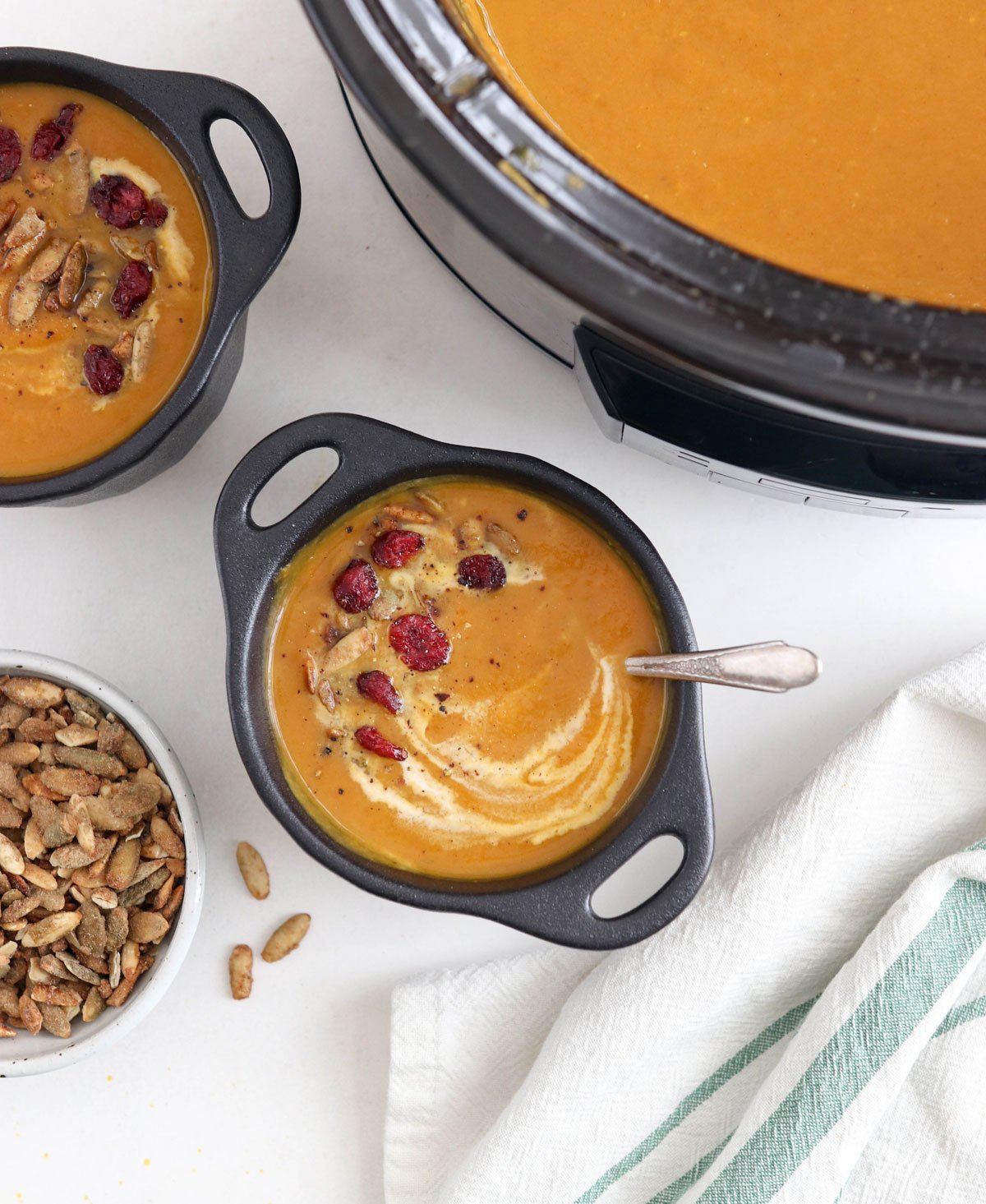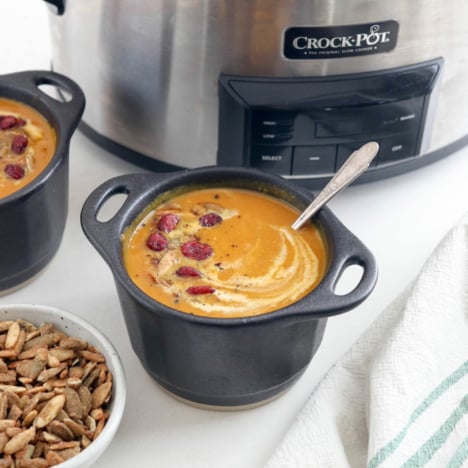How to Make Pumpkin Soup in a Slow Cooker
This soup recipe is remarkably easy, using canned pumpkin for convenience. You can probably use a fresh pumpkin if you have it, too, but you’ll want to add a little more liquid in that case. (And the prep time will be significantly increased, since you’ll have to peel, chop, and de-seed the pumpkin before you get started.) Here’s what you’ll need to have on hand:
Canned pumpkin (2 cans!) Onion Garlic Ginger Ground Cinnamon Ground Turmeric Maple syrup Coconut Milk
When using a slow cooker, unlike an Instant Pot (see the notes below for a pressure cooker option), you’ll need to use a separate pan to saute the onions, garlic, and ginger first. This quick cooking process helps the onions have a milder, sweeter flavor, which is nice in this soup, because pumpkin has a pretty mild flavor on its own. You don’t want to overpower it with raw onion!
After you’ve sauteed the onion, garlic, and ginger, you’ll stir in the cinnamon and turmeric for a minute, just to help release their aromatic flavor, and then you’ll pour it all into your slow cooker. Add in the pumpkin, some water (or broth– but I don’t usually keep that on hand), maple syrup, and salt, and then you just have to press a button and walk away! The soup will cook while you’re at work or school, or while you’re busy getting other things done. No need to worry about dinner anymore!
Why Is Pumpkin Soup Healthy?
Pumpkins are one of my favorite varieties of winter squash. They are low in calories and high in water content, and their bright orange color is a sign that they are high in beta-carotene, too. Here are a few more Pumpkin Benefits:
Pumpkins contain antioxidants, including alpha-carotene and beta-carotene, which may help prevent free radical damage in the body. (source) The beta-carotene in pumpkins is turned into vitamin A in the body, and that may help to strengthen your immune system. (source) Pumpkin is also high in vitamin C, which may help to increase white blood cell production (which protect the body from infection). In addition to beta-carotene, pumpkins are a good source of Lutein and Zeaxanthin, which may work together to help to protect your eye health and lower the risk of age-related eye diseases. (source)
If you do use fresh pumpkin, don’t forget to take advantage of all the nutrition found in their seeds. You can make my Roasted Squash Seeds as a topping for this delicious soup, or use a store-bought option for added crunch.
How to Make the Best Pumpkin Soup (Don’t skip these tips!)
This recipe calls for canned pumpkin, because it’s faster and easier to work with, but keep in mind that canned pumpkin can vary pretty drastically in texture. I tested this soup 3 times with 3 different brands of pumpkin puree, and the results were different each time. This is frustrating as a recipe developer, so I want to give you all the tips I picked up along the way.
This recipe starts with just 2 cups of liquid, in case your canned pumpkin is runny in texture. If you add too much liquid right away, the resulting soup could turn out too thin. I’ve found that organic canned pumpkin tends to be more watery in texture compared to non-organic canned pumpkin. Because of the two notes above, the amount of salt and maple syrup will change each time you make this recipe. In the recipe below, I’ve started with the minimum amount I think you should use, but if you end up adding another cup or two of water to this recipe, you’ll need to compensate by adding more flavor! Please don’t serve your friends or family members bland soup. Add enough salt and maple syrup until the soup tastes good to your taste buds. These two ingredients work together to bring out the flavor from the other ingredients in the soup, so don’t be stingy.
You can see the whole process in the cooking video below, because this was the thickest canned pumpkin I’ve tried to date! I have to add an extra cup of water to the soup before even cooking it, and then I add even more liquid once the cooking time is over, until the soup is as thick as I want it to be. Recipe Notes:
I like the added creaminess from the coconut milk, but you can use almond milk, oat milk, or hemp milk in this recipe, if you prefer. If you don’t need a dairy-free or vegan recipe, you can use real cream instead. If you don’t want to take the time to blend this soup, you can serve it as-is, with flecks of onion throughout. When you serve it with a topping, like dried cranberries & pumpkin seeds, they aren’t too noticeable. To make this soup in the Instant Pot, I would sauté the onion, garlic, and ginger first (in the same pot), then add the ingredients, making sure that the soup is no too thick. (It should be slightly runny in texture for pressure cooking, so make sure you eyeball it with the liquid– 3 cups of water is a safe bet.) Cook at high pressure for 10 minutes, then let the pressure naturally release for at least 10 minutes before moving the steam release valve to venting. See my Instant Pot Butternut Squash Soup for more step-by-step Instant Pot tips.
If you try this recipe, please leave a comment below letting me know what you think. And if you make any modifications, I’d love to hear about those, too!




